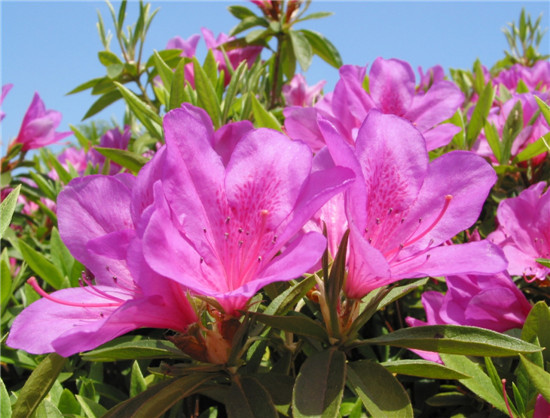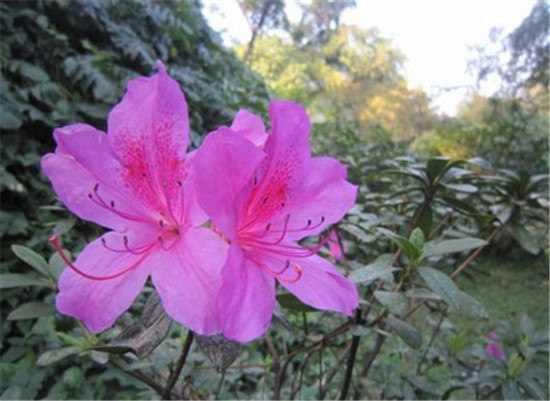Cultivation skills of rhododendron daily maintenance of rhododendron
There may not be many people who have seen this kind of plant, so let's take a look at the cultivation skills and daily maintenance of Maojuan's rhododendron.

Cuckoos like cool, moist and sunny environments. Cold-resistant, heat-resistant, semi-overcast, not resistant to long-term strong light exposure. The suitable temperature for growth is 15-28 ℃ and can withstand low temperature of-8 ℃ in winter. The soil should be acid sandy loam which is fertile, loose and well drained. Traditional varieties include "Jade Butterfly", "Purple Butterfly", "Ryukyu Red", "Yuling" and so on. Rhododendron, summer cuckoo, western rhododendron, honeysuckle, Yunyin rhododendron. Fertilize once a year before and after flowering, cut off the overdense bore branches, truncate only long branches, and cut off dead and diseased branches. The rhododendron is planted in pieces, and the flowers are colorful and colorful, which can add to the natural landscape effect of the garden. From large trees (up to more than 20m in height) to small shrubs (only 10cm-20cm in height), the trunk is erect or creeping, with alternate or whorled branches.
Evergreen or semi-evergreen shrubs, up to 3m tall, sparsely branched, young branches densely light brown flattened tomentose, leaves papery, dimorphic, elliptic to elliptic-lanceolate or rectangular oblanceolate, 2.5-5.6cm long, 8-18mm wide, tip acute, with convex tip, base cuneate, initially scattered yellow sparse hairs, later subglabrous, tip obtuse, base cuneate, margin with eyelashes, petiole hairy, petiole long 4-6mm The surface and back of the leaves are hairy and the midrib is more, and the autumn leaves are narrow and long, Obovate or oval-lanceolate, thick and shiny.

Cultivation techniques of rhododendron
Basin soil
Acidic soil is required to be loose, well drained and rich in humus. Take 4 parts of humus soil, 2 parts of old basin soil, 1 part of sandy soil, 1 part of burning soil and 1 part of sawdust, mix with proper amount of cake fertilizer and compost for half a month.
Upper basin
When potting, the seedlings take more soil, less damage to the roots, the long roots are shortened appropriately, and the larger plants should be pruned to the upper branches. First, cover the drainage hole of the basin bottom with broken tiles in the flowerpot, spread a layer of coarse-grained soil as the drainage layer, fill part of the culture soil in the center, put the plant into the pot and add soil to compaction. The planting depth is the same as that when the original seedlings were unearthed. Water it thoroughly.
Watering
Afraid of both dryness and waterlogging. From the end of November to the middle and early February of the following year, most of the open-field potted rhododendrons were dormant or semi-dormant, and they were properly watered according to the dry and wet condition of the basin soil. The temperature rose in late February, the flower buds and leaf buds sprouted, and the watering times were increased appropriately. The peak period of new shoot growth is from March to June, and the water demand increases, so it is necessary to increase the watering times. The temperature is high from July to September and it has to be watered every day. After October, the amount of water can be reduced.

Fertilizer application
If you don't like big fertilizer, you should apply thin fertilizer frequently. Base fertilizer with long-acting fertilizer, such as cake fertilizer, bone meal and dry stable manure and other organic fertilizer, in the upper basin to change the basin or buried in the basin soil in winter. Topdressing with quick-acting fertilizer, such as human manure organic fertilizer or nitrogen, phosphorus, potassium fertilizer, the Beginning of Spring before flowering, apply phosphorus and potassium fertilizer 1-2 times a month, stop fertilization when flowering. Apply liquid fertilizer mainly with phosphate fertilizer for 1-2 times after cool autumn, and stop topdressing after winter.
Key points of cultivation
Potted plants change pots after flowering every spring and use acidic soil rich in humus. Usually watering should be timely, especially at the flowering stage, to keep the pot soil dry. Fertilizer and water is the key to growth and development, fertilizing once every semimonthly or using Huiyou 21-7-7 acid fertilizer. Growth is basically stagnant in winter, so fertilizer and water should be strictly controlled. During the growing period, it is necessary to prune and remove withered branches and sprouting branches, which is conducive to the balanced development of the tree. The planting chooses the acidic soil with high dryness, sufficient sunshine and deep soil layer. Fertilize once a year before and after flowering, cut off the overdense bore branches, truncate only long branches, and cut off dead and diseased branches.

Newly decorated houses are not suitable for raising cuckoos, because harmful gases such as formaldehyde in decorated houses have not dissipated, which is easy to cause harm to cuckoos. Cuckoos and cuckoos are difficult to raise flowers, so it is necessary to carefully grasp the habits of flowers when planting rhododendrons. The eyes are full of colorful fragrant spring, when the rhododendron blooms mature, it can produce a purple similar to the rose. Friends who like to grow flowers can try to plant such colorful flowers, which will certainly make your life a different color.
The above is the whole content of the cultivation skills and daily maintenance of rhododendron that I summarized for you. I hope this article can help you. Please continue to follow us.
Related
- Wuhan Hospital Iron Tree Blooming Result Was Instantly Frightened by the Gardener Master
- Which variety of camellia is the most fragrant and best? Which one do you like best?
- What is the small blue coat, the breeding methods and matters needing attention of the succulent plant
- Dormancy time and maintenance management of succulent plants during dormancy
- Minas succulent how to raise, Minas succulent plant pictures
- What are the varieties of winter succulent plants
- How to raise succulent plants in twelve rolls? let's take a look at some experience of breeding twelve rolls.
- Attention should be paid to water control for succulent plants during dormant period (winter and summer)
- Watering experience of twelve rolls of succulent plants
- Techniques for fertilizing succulent plants. An article will let you know how to fertilize succulent plants.



